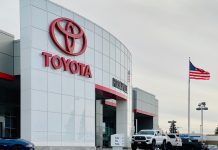Let Buyers Do It at Home
Most dealerships understand that much of the car-buying process takes place online. From comparing different makes and models to researching pricing and trade-in values, car shoppers do a lot of homework—ranging from 11 to 17 hours—before they contact a dealership. Not surprisingly, a lot of that research happens on dealership websites, especially as buyers check out prices, photos, inventory, and even service-department details.
And yet, very few car dealerships offer an e-commerce option to let buyers close a deal from the comfort of their own home.
This traditional, in-person sales model may make sense to auto dealers—after all, this is the way business has always been conducted—but it makes less and less sense to consumers, who are used to buying what they want, when they want, without setting foot in a store.
“Today, tools are available that can translate a positive real-world buying experience to a seamless online sale, with less friction for buyers and more profit for dealers.”
A new car-buying dynamic
Several studies, including a global survey of more than 10,000 car buyers conducted by Accenture, indicate that a clear majority of consumers would be interested in conducting the entire buying process online. Despite this clear desire, many dealerships are reluctant to transform their existing websites from an interactive, online brochure to a sales channel that collects orders 24 hours a day.
Dealers’ primary concerns often revolve around price and financing. They’re afraid that publishing vehicle prices will lead to a reverse-bidding war, where consumers pit dealerships against one another in their quest for rock-bottom deals. They also worry that presenting complex finance and insurance products online will have an adverse effect on the bottom line.
Other, equally valid reasons to avoid taking the e-commerce plunge come from the technology options themselves. Until recently, online checkout solutions have typically been complicated and expensive to implement, often using a third-party website for the actual sales transaction. Even worse, these costly tools may omit critical steps in the buying process; they create more work—and negative customer experiences.
However, the e-commerce world continues to evolve at warp speed. Today, tools are available that can translate a positive real-world buying experience to a seamless online sale, with less friction for buyers and more profit for dealers.
Higher per-vehicle profit
More than 150 automotive dealers have added e-commerce to their websites, including three of the largest dealer groups in the country. Atlanta-based Asbury Automotive began testing online checkout in early 2016 and many of their stores saw their first sales within hours of going live. Since then, the company has adopted e-commerce at more than 90 percent of its 82 rooftops.
Other dealers have reported similar success stories:
An analysis of more than 75 dealerships in the last nine months shows dealers averaged $2,000 higher gross profit for cars sold online, resulting from higher sticker prices and more F&I products.
Many dealerships realize returns on investment (ROIs), ranging from 10 to 20 times the cost of the e-commerce solution within the first month of implementation.
“After decades of failed technology offerings, the automotive industry can now capitalize on the growing trend toward e-commerce.”
Dealers consistently see 25 percent higher F&I profit with online sales.
These figures don’t include the labor efficiencies of having consumers pre-fill data online, automatically populating the dealer’s financing and customer relationship management (CRM) software. Consumers can often finish the sale and drive off in their new car in less than an hour (pro tip: Using electronic signatures makes the process even faster).
Ironically, dealers’ top concerns about online checkout—pricing and F&I products—are the main drivers behind higher profits. Buyers have demonstrated their willingness to pay a premium for the convenience of e-commerce. Similarly, when allowed to consider F&I options at their leisure, more than 50 percent of consumers include at least one add-on.
Best practices for online sales
Any dealership can add e-commerce to their website, but not all auto dealers have the systems in place to succeed online. In its simplest form, e-commerce works like a virtual cash register. However, cash registers don’t generate sales in a vacuum; they facilitate the sales created by the rest of the business, working in concert to meet customers’ needs.
The dealers that have had the greatest success with online sales typically have the following:
Elegant virtual showroom. The dealer’s website needs to reflect the same care and attention to detail as the physical showroom floor. The cars have center stage, featured in high-quality images. The site design should make it easy for customers to click through, browse, and buy inventory. Converting site traffic into sales requires clearly labeled pricing, directly adjacent to a straightforward call-to-action. In other words, dealers need to make it abundantly clear what they want customers to do on that web page. Adding a “buy now” button allows dealers to make money by capitalizing on the customer’s immediate excitement about the vehicle.
Fair pricing. Dealerships need to advertise fair, competitive prices for their cars, but they don’t have to put their lowest prices online. Having the option to buy online removes the threat of a price war. Thanks to a variety of online resources, most consumers already know what to expect in terms of price. With a decent price and an easy checkout process, most people will buy in the moment. The convenience factor usually trumps the desire for the best possible deal.
Steady lead generation. Online sales are often a numbers game. If dealers want to succeed in e-commerce, they need to acquire traffic for their product pages: literally, thousands of unique visitors per day. To make the best use of their online advertising, dealers need to target the right visitors—namely, those who are planning to buy a car in the near future. Challenges in online marketing include rapid market saturation and skyrocketing keyword costs. Using a company like Shift Digital, which specializes in digital marketing for auto retailers, allows dealerships to focus on what they do best: taking care of customers.
Responsive service. One of the keys to successful e-commerce is prompt, professional customer service. The sales team needs to recognize that online orders are not leads, but closed deals, and should be treated as such. When an e-commerce order comes in during business hours, the dealer should call the customer within minutes—certainly within two hours—to arrange pick-up or delivery of the car. Then, the dealership should have the paperwork completed and ready to go when the pick-up or drop-off occurs. In addition to speed, accuracy is critical. Dealers need to make sure that the delivered car and terms match those ordered by the customer. Supporting online sales with rapid response and consistent, high-quality service will create a positive buying experience—ultimately leading to die-hard fans and future sales.
Take a free test drive
After decades of failed technology offerings, the automotive industry can now capitalize on the growing trend toward e-commerce. New solutions have emerged that are both affordable and easy to integrate with a dealership’s current website. When paired with fair pricing and a positive customer experience, e-commerce allows buyers to close themselves at their convenience, essentially turning their home computers and mobile devices into cash registers that generate sales around the clock.
Some of these solutions offer risk-free trial periods. During this time, a dealership can determine how well its current business operations support e-commerce. These trials also provide a firsthand look at how the convenience of online sales influences per-vehicle profitability.
The future of automotive e-commerce has arrived, finally putting dealerships in the driver’s seat.








